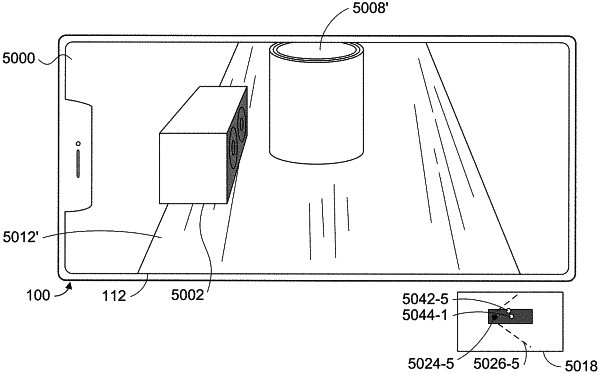| CPC G06T 19/006 (2013.01) [G06F 3/04815 (2013.01); G06T 7/70 (2017.01)] | 24 Claims |

|
1. A method, comprising:
at a computer system having a display generation component and one or more cameras:
displaying, via the display generation component, a representation of a field of view of the one or more cameras, wherein the field of view includes a physical object in a physical environment, and the representation of the field of view of the one or more cameras includes a representation of the physical object;
receiving one or more inputs corresponding to a request to display the representation of the field of view with the physical object at a first pose in the physical environment, a virtual object at a simulated second pose in the physical environment, and the one or more cameras at a third pose in the physical environment; and
in response to receiving the one or more inputs:
in accordance with a determination that a first portion of the virtual object corresponds to physical space in the physical environment that is occluded by the physical object in the physical environment:
displaying the representation of the physical object;
forgoing displaying the first portion of the virtual object; and
in accordance with a determination that a second portion of the virtual object corresponds to physical space in the physical environment that is not occluded:
displaying the second portion of the virtual object, including visually deemphasizing a displayed first region of the second portion of the virtual object relative to a displayed second region of the second portion of the virtual object;
wherein:
the first portion of the virtual object corresponds to physical space in the physical environment that is occluded by the physical object in the physical environment, and the second portion of the virtual object corresponds to physical space in the physical environment that is not occluded;
a first set of environmental conditions are present in the physical environment; and
the method further includes:
detecting a change to a second set of environmental conditions in the physical environment; and
while the second set of environmental conditions are present in the physical environment, the physical object is at the first pose in the physical environment, the virtual object is at the simulated second pose in the physical environment, and the one or more cameras are at the third pose in the physical environment:
displaying the representation of the physical object;
forgoing displaying the first portion of the virtual object; and
displaying a third portion of the virtual object, different from the second portion, including visually deemphasizing a displayed first region of the third portion of the virtual object relative to a displayed second region of the third portion of the virtual object, wherein visually deemphasizing the displayed first region of the third portion of the virtual object is in accordance with the change to the second set of environmental conditions in the physical environment.
|